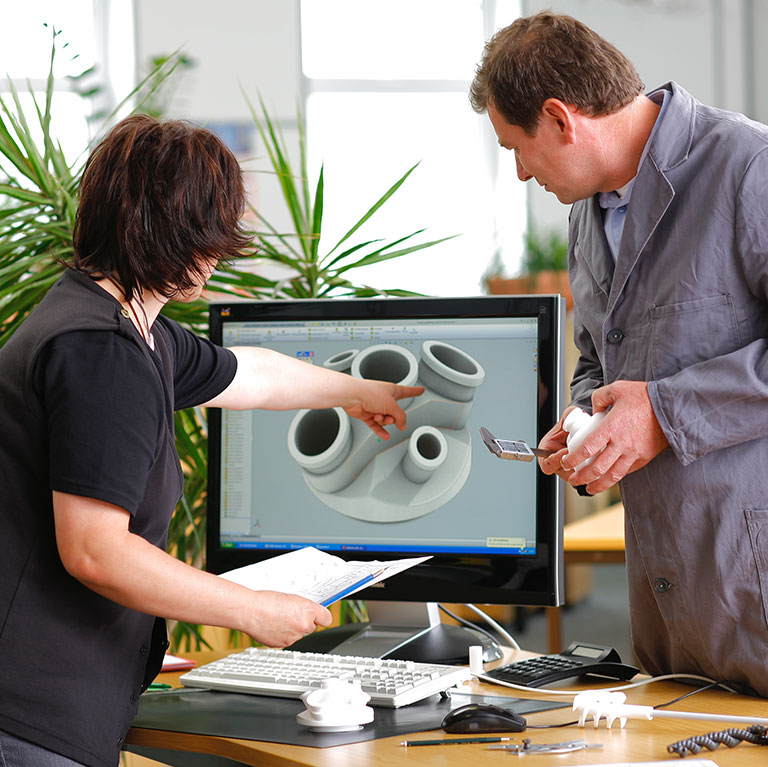Choice and Assembly
Choice of wall thickness
When choosing the wall thickness, a couple of issues have to be considered:
- What max. pressure » will be applied? In the charts on page 226 the minimum wall thickness can easily be found.
- To which temperatures will the tubing be exposed? The maximum pressure has to be reduced by the stated factors.
- Shall the tubing be applied under vacuum? Then the wall thickness has to be sufficient (rule of thumb)

Fitting and tubing have to fit
Practice has proved that tubing varies in diameter. We therefore recommend to check before assembly whether the tubing outer diameter corresponds to the nominal size (e. g. Ø 6 mm). The values in the right chart will be helpful. The surface of PTFE tubing can be damaged if V-rings are inserted by force and result in leakage.

Easy assembly
First check whether your laboratory screw joint (inner diameter) fits your tubing (outer diameter). If it is still difficult to put the tubing inside the inner parts of the laboratory screw joint, a trick can be helpful. Just either sharpen the tubing with a simple sharpener or cut it diagonally. You should now be able to easily put the tubing through the inner parts.

Transition from imperial to metric tubing
With BOLA Tube Fittings and Reducing Unions, transition from imperial to metric tubing or connections between both can easily be made. For example: A pipe socket of an analytical device with an outer diameter of 1/4" shall be connected to a PTFE tubing with an outer diameter of 8 mm.
Needed components: Reducing union 6 mm to 8 mm (Cat.No. D 526-10) and a set of tapered V-rings O 1/4" (6.35 mm; Cat.No. D 502-03). By exchanging the 6 mm V-rings with the 1/4" V-rings, the pipe socket can be connected to the 1/4" reducing union and the 8 mm PTFE tubing on the other side.

BOLA Laboratory Screw Joints
Application
BOLA Laboratory Screw Joints are the perfect choice to connect hardwalled tubing (e. g. PTFE, PFA, FEP) or tubes in different materials (such as glass, metall, plastics) with devices with GL-threads.

Components
Each laboratory screw joint consists of a cap with female GL-thread, bore and internal cone as well as a set of three inner parts: v-ring, tapered ring and sealing ring. For laboratory screw joints for tubing O. D. smaller than 3 mm, the sealing ring includes additionally a FPM-o-ring which is protected by a PTFE sealing lip. The special clou of BOLA’s Laboratory Screw Joint System: You can connect different tubing diameters to the same GL thread by simply exchanging the inner spare parts. It is not necessary to adapt the GL thread or fitting. A reduction is made by exchanging the inner spare parts instead of adapting the GL thread.


Choice
A suitable laboratory screw joint for your connection can easily be found. First of all, the outer diameter of the tubing or tube and the size of the GL thread to which the laboratory screw joint shall be connected have to be determined. Further assistance on the determination of threads can be found in our technical appendix. Also the application is decisive: Will there be temperatures of more than +150 °C? If so, the BOLA Laboratory Screw Joints HT in PPS (black) are the right choice. PPS provides besides at once a good thermal and chemical resistance. Or is a high chemical resistance more important? Then you have to choose BOLA Laboratory Screw Joints in ETFE (red) on page XXX. In comparison to PPS, they provide a better chemical resistance but can be used only up to max. +150 °C. For more flexibility, all screw caps and sets of inner spare parts can also be ordered separately.


Assembly and Function
Assembly can easily made by hand. First, the screw cap has to be put on the tubing end, that shall be mounted to the GL socket. After that, the inner parts are pushed on the tubing. Please pay attention to the right order: slotted v-ring, tapered ring and o-ring for O.D. smaller than 3 mm, sealing ring as well as on the correct mounting orientation. A schematic drawing on our labels repeats this information. Push the tubing through the GL socket, place the inner parts on the sealing surface of the GLthread and finally fix the connection by tightening the screw cap. The screw cap presses firmly the sealing ring and the tapered ring on the GLthreaded counter piece. At the same time, the v-ring is compressed and the tubing is fixed tightly as well. The complete connection is tight. Provided the laboratory screw joint is exposed to changing working temperatures, it might be necessary to tighten the screw joints once more due to different expansion coefficients of the used materials PTFE and PPS/ETFE.









